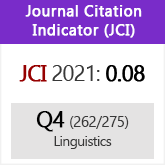A corpus study of durational rhythmic measures in the Kalhori variety of Kurdish
DOI:
https://doi.org/10.3989/loquens.2023.e098Keywords:
durational variability, acoustic correlations, rhythmic measures, Kalhori, KurdishAbstract
In order to identify between-sentence and between-speaker variabilities, one of the methods used by phoneticians is studying durational rhythmic features. In the present research, to classify speech rhythm of Kalhori, a variety of Kurdish, and to find out about the most appropriate measures for between-sentence and between-speaker rhythmic variability in Kalhori, durational speech rhythmic measures were analyzed. To this end, two speaking styles (read and spontaneous) were explored. The analysis of the read corpus revealed that Kalhori Kurdish rhythm pattern is between stress-timed and syllable-timed. The results indicated that %V (proportion over which speech is vocalic) was the most significant measure for distinguishing between-sentence rhythmic variability in the read corpus, while %V and rateSyl (syllable rate) were the most efficient measures for identifying the between-speaker rhythmic variability in both the read and spontaneous corpus.
Downloads
References
Arvaniti, A., Ladd, D. R., & Mennen, I. (1998). Stability of tonal alignment: the case of Greek prenuclear accents. Journal of phonetics, 26(1), 3-25. https://doi.org/10.1006/jpho.1997.0063
Arvaniti, A. (2012). The usefulness of metrics in the quantification of speech rhythm. Journal of Phonetics, 40(3), 351-373. https://doi.org/10.1016/j.wocn.2012.02.003
Asadi, H., Nourbakhsh, M., He, L., Pellegrino, E., & Dellwo, V. (2018). Between-speaker rhythmic variability is not dependent on language rhythm, as evidence from Persian reveals. International Journal of Speech, Language and the Law, 25(2), 151-174. https://doi.org/10.1558/ijsll.37110
Baird, L., Evans, N., & Greenhill, S. J. (2022). Blowing in the wind: Using 'North Wind and the Sun' textsto sample phoneme inventories. Journal of the International Phonetic Association, 52(3), 453-494. https://doi.org/10.1017/S002510032000033X
Barbosa, P. A. (2002). Explaining cross-linguistic rhythmic variability via a coupled-oscillator model of rhythm production. In Speech Prosody 2002 https://doi.org/10.21437/SpeechProsody.2002-26
Barbosa, P., & Bailly, G. (1994). Characterisation of rhythmic patterns for text to-speech synthesis. Speech Communication, 15(1-2), 127-137. https://doi.org/10.1016/0167-6393(94)90047-7
Belelli, S. (2019). Towards a dialectology of Southern Kurdish: Where to begin. Current issues in Kurdish linguistics, 73, 92. https://doi.org/10.20378/irb-56759
Bertrán, A. P. (1999). Prosodic typology: on the dichotomy between stress-timed and syllable-timed languages. Language design: journal of theoretical and experimental linguistics, 2, 103-130.
Borjian, H. (2017). Kermanshah vii. languages and dialects. İçinde Encyclopædia Iranica. Erişim tarihi: 14 Temmuz 2021.
Brown, K. (2005). Encyclopedia of language and linguistics (Vol. 1). Elsevier, 634-38.
Cummins, F., & Port, R. (1998). Rhythmic constraints on stress timing in English. Journal of Phonetics, 26(2), 145-171. https://doi.org/10.1006/jpho.1998.0070
Dabirmoghadam, M. (2013). Typology of Iranian 2. Tehran: SAMT.
Daneshpazhouh, F. (2010). Ergativity in Kurmanji (Badini), Sorani and Hawrami Kurdish,Tehran: Dastan.
Dauer, R. M. (1983). Stress-timing and syllable-timing reanalyzed. Journal of phonetics, 11(1), 51-62. https://doi.org/10.1016/S0095-4470(19)30776-4
Dellwo, V., Huckvale, M., & Ashby, M. (2007). How is individuality expressed in voice? An introduction to speech production and description for speaker classification. Speaker Classification I: Fundamentals, Features, and Methods, 1-20. https://doi.org/10.1007/978-3-540-74200-5_1
Dellwo, V., Schmid, S., Schwarzenbach, M., & Studer-Joho, D. (2009). Choosing the right rate normalization method for measurements of speech rhythm.
Dellwo, V. (2010). Influences of Speech Rate on the Acoustic Correlates of Speech Rhythm: An Experimental Phonetic Study Based on Acoustic and Perceptual Evidence. Doctoral dissertation, Bonn University, Germany.
Dellwo, V., Leemann, A., & Kolly, M. J. (2012, September). Speaker idiosyncratic rhythmic features in the speech signal. Interspeech Conference Proceedings.http://interspeech2012.org/accepted-abstract.html?id=1195 https://doi.org/10.21437/Interspeech.2012-342
Dellwo, V., & Fourcin, A. (2013). Rhythmic characteristics of voice between and within languages. Travaux neuchâtelois de linguistique, (59), 87-107. https://doi.org/10.26034/tranel.2013.2947
Dellwo, V., Leemann, A., & Kolly, M. J. (2015). Rhythmic variability between speakers: Articulatory, prosodic, and linguistic factors. The Journal of the Acoustical Society of America, 137(3), 1513-1528. https://doi.org/10.1121/1.4906837 PMid:25786962
Fattah, I.K. (2000). Les dialectes kurdes méridionaux: Étude linguistique et dialectologique (Acta Iranica 37). Leuven: Peeters.
Fuchs, R. (2016). The Concept and Measurement of Speech Rhythm. In: Speech Rhythm in Varieties of English. Prosody, Phonology and Phonetics. Springer, Berlin, Heidelberg. https://doi.org/10.1007/978-3-662-47818-9
Gharib, H. E. (2011). Transitivity alternations in Sorani Kurdish (Doctoral dissertation, University of Kansas). http://hdl.handle.net/1808/9791
Gibbon, D. (2022). Speech rhythms: learning to discriminate speech styles. Proc. Speech Prosody 2022, 302-306. https://doi.org/10.21437/SpeechProsody.2022-62
Gibbon, D. (2022). New Perspectives on Ibibio Speech Rhythm. In Current Issues in Descriptive Linguistics and Digital Humanities: A Festschrift in Honor of Professor Eno-Abasi Essien Urua (pp. 457-486). Singapore: Springer Nature Singapore. https://doi.org/10.1007/978-981-19-2932-8_34
Gibbon, D. (2023). The rhythms of rhythm. Journal of the International Phonetic Association, 53(1), 233-265. https://doi.org/10.1017/S0025100321000086
Grabe, E., & Low, E. L. (2002). Durational variability in speech and the rhythm class hypothesis. Papers in laboratory phonology, 7(1982), 515-546. https://doi.org/10.1515/9783110197105.2.515
Harrington, J. (2010). Phonetic analysis of speech corpora. John Wiley & Sons.
He, L. (2022). Characterizing first and second language rhythm in English using spectral coherence between temporal envelope and mouth opening-closing movements. The Journal of the Acoustical Society of America, 152(1), 567-579. https://doi.org/10.1121/10.0012694 PMid:35931510
He, L., & Dellwo, V. (2016). The role of syllable intensity in between-speaker rhythmic variability. International Journal of Speech, Language & the Law, 23(2). https://doi.org/10.1558/ijsll.v23i2.30345
James, A. L. (1929). Historical introduction to French Phonetics, London: ULP.
James, A. L. (1938). Our spoken language (No. 9). London: T. Nelson.
James, G., Witten, D., Hastie, T., & Tibshirani, R. (2013). An introduction to statistical learning (Vol. 112, p. 18). New York: springer. https://doi.org/10.1007/978-1-4614-7138-7
Karimi-Doostan, G. (2002). Syllable structure in Kurdish language. Specialized Journal of Language and Literature of Mashhad Faculty of Literature and Human Sciences, 35(2), 235-248.
Kreyenbroek, P. G. (2005). On the Kurdish language. In The Kurds (pp. 62-73). Routledge. https://doi.org/10.4324/9780203993415
Lee, C. S., & Todd, N. P. M. (2004). Towards an auditory account of speech rhythm: application of a model of the auditory 'primal sketch'to two multi-language corpora. Cognition, 93(3), 225-254. https://doi.org/10.1016/j.cognition.2003.10.012 PMid:15178378
Lee, C. S., Kitamura, C., Burnham, D., & McAngus Todd, N. P. (2014). On the rhythm of infant-versus adult-directed speech in Australian English. The Journal of the Acoustical Society of America, 136(1), 357-365. https://doi.org/10.1121/1.4883479 https://doi.org/10.1121/1.4883479 PMid:24993220
Leemann, A., Kolly, M. J., & Dellwo, V. (2014). Speaker-individuality in suprasegmental temporal features: Implications for forensic voice comparison. Forensic science international, 238, 59-67. https://doi.org/10.1016/j.forsciint.2014.02.019 PMid:24675042
Leong, V., & Goswami, U. (2014). Impaired extraction of speech rhythm from temporal modulation patterns in speech in developmental dyslexia. Frontiers in human neuroscience, 8, 96. https://doi.org/10.3389/fnhum.2014.00096 PMid:24605099 PMCid:PMC3932665
Leong, V., Stone, M. A., Turner, R. E., & Goswami, U. (2014). A role for amplitude modulation phase relationships in speech rhythm perception. The Journal of the Acoustical Society of America, 136(1), 366-381. https://doi.org/10.1121/1.4883366 PMid:24993221
Liss, J. M., White, L., Mattys, S. L., Lansford, K., Lotto, A. J., Spitzer, S. M., & Caviness, J. N. (2009). Quantifying speech rhythm abnormalities in the dysarthrias. Journal of speech, language, and hearing research: JSLHR, 52(5), 1334-1352. https://doi.org/10.1044/1092-4388(2009/08-0208) PMid:19717656
Loukina, A., Kochanski, G., Rosner, B., Keane, E., & Shih, C. (2011). Rhythm measures and dimensions of durational variation in speech. The Journal of the Acoustical Society of America, 129(5), 3258-3270. https://doi.org/10.1121/1.3559709 PMid:21568427
Magne, C., Jordan, D. K., & Gordon, R. L. (2016). Speech rhythm sensitivity and musical aptitude: ERPs and individual differences. Brain and Language, 153-154, 13-19. https://doi.org/10.1016/j.bandl.2016.01.001 PMid:26828758
MacKenzie, D. N. (1961). Kurdish Dialect Studies, Volume I. [2. Reprint, 1990, London: SOAS] London: Oxford University Press. Page references are to the reprint edition.
McCarus, E. N. (1958). A Kurdish Grammar: Descriptive Analysis of the Kurdish of Sulaimaniya, Iraq. American Council of Learned Societies Program in Oriental Languages, Publications Series B-Aids-Number 10.
McCarus, E. N. (2009). Kurdish. In G. Windfuhr Ed. London & New Yourk: Routledg.
McDougall, K. (2004). Speaker-specific formant dynamics: an experiment on Australian English/aI. International Journal of Speech, Language and the Law, 11(1), 103-130. https://doi.org/10.1558/sll.2004.11.1.103
McDougall, K. (2006). Dynamic features of speech and the characterization of speakers: Toward a new approach using formant frequencies. International Journal of Speech, Language and the Law, 13(1), 89-126. https://doi.org/10.1558/ijsll.v13i1.89
Malisz, Z., O'Dell, M., Nieminen, T., & Wagner, P. (2017). Perspectives on speech timing: Coupled oscillator modeling of Polish and Finnish. Phonetica, 73(3-4), 229-255. https://doi.org/10.1159/000450829 PMid:28208147
Mok, P., & Dellwo, V. (2008, May). Comparing native and non-native speech rhythm using acoustic rhythmic measures: Cantonese, Beijing Mandarin and English. In: Speech Prosody 2008, Campinas, Brazil. ISCA, 423-426. https://doi.org/10.21437/SpeechProsody.2008-93
Nolan, F. (2002). Intonation in speaker identification: an experiment on pitch alignment features. International Journal of Speech, Language and the Law, 9(1), 1-21. https://doi.org/10.1558/sll.2002.9.1.1
O'Dell, M., & Nieminen, T. (1999, August). Coupled oscillator model of speech rhythm. In Proceedings of the XIVth international congress of phonetic sciences (Vol. 2, pp. 1075-1078). Berkeley: University of California.
Pellegrino, E. (2019). The effect of healthy aging on within-speaker rhythmic variability: A case study on Noam Chomsky. Loquens, 6(1), e060. https://doi.org/10.3989/loquens.2019.060
Pointon, G. E. (1980). Is Spanish really syllable-timed? Journal of Phonetics, 8(3), 293-304. https://doi.org/10.1016/S0095-4470(19)31479-2
Polyanskaya, L., & Ordin, M. (2015). Acquisition of speech rhythm in first language. The Journal of the Acoustical Society of America, 138(3), EL199-EL204. https://doi.org/10.1121/1.4929616 PMid:26428813
Pike, K. L. (1945). The Intonation of American English. Ann Arbor: University of Michigan Press.
Ramus, F., Nespor, M., & Mehler, J. (1999). Correlates of linguistic rhythm in the speech signal. Cognition, 73(3), 265-292. https://doi.org/10.1016/S0010-0277(99)00058-X PMid:10585517
Roach, P. (1982). On the distinction between 'stress-timed'and 'syllable-timed'languages. Linguistic controversies. in Crystal, Linguistic controversies: essays in linguistic theory and practice in honour of F.R. Palmer, 73-79.
Stevens, J. (1996). Applied multivariate statistics for the social sciences. Mahway, NJ: Lawrence Erlbaum.
Thackston, W. M. (2006). Kurmanji Kurdish:-A Reference Grammar with Selected Readings. Renas Media.
Taghva, N., Abolhasani Zade, V., and Moloodi, A., (2021). Durational rhythmic variability of Persian between-sentence, Presented at SLE 2021, Socities Linguistica Europia, 223-224.
Tilsen, S., & Johnson, K. (2008). Low-frequency Fourier analysis of speech rhythm. The Journal of the Acoustical Society of America, 124(2), EL34-EL39. https://doi.org/10.1121/1.2947626 PMid:18681499 PMCid:PMC5570052
Tilsen, S. (2016). Selection and coordination: The articulatory basis for the emergence of phonological structure. Journal of Phonetics, 55, 53-77. https://doi.org/10.1016/j.wocn.2015.11.005
Tilsen, S., & Arvaniti, A. (2013). Speech rhythm analysis with decomposition of the amplitude envelope: Characterizing rhythmic patterns within and across languages. The Journal of the Acoustical Society of America, 134(1), 628-639. https://doi.org/10.1121/1.4807565 PMid:23862837
Todd, N. P. M. (1994). The auditory "primal sketch": A multiscale model of rhythmic grouping. Journal of new music Research, 23(1), 25-70. https://doi.org/10.1080/09298219408570647
White, L., & Mattys, S. L. (2007). Calibrating rhythm: First language and second language studies. Journal of Phonetics, 35(4), 501-522. https://doi.org/10.1016/j.wocn.2007.02.003
White, L., Liss, J. M. & Dellwo, V. (2010). Assessment of rhythm. In A. Lowit and R.D. Kent ed. Assessment of Motor Speech Disorders, 312-352, San Diego: Plural Publishing.
Wiget, L., White, L., Schuppler, B., Grenon, I., Rauch, O., & Mattys, S. L. (2010). How stable are acoustic metrics of contrastive speech rhythm? The Journal of the Acoustical Society of America, 127(3), 1559-1569. https://doi.org/10.1121/1.3293004 PMid:20329856
Windfuhr, G. (1989). West Iranian Dialects. In R Schmitt, ed. Compendium Liguarum Iranicum, 294-295, Wiesbaden: Reichert.
Yoon, T. J. (2010). Capturing inter-speaker invariance using statistical measures of rhythm. Speech Prosody 2010, 100201, 1-4. https://doi.org/10.21437/SpeechProsody.2010-58
Published
How to Cite
Issue
Section
License
Copyright (c) 2023 Consejo Superior de Investigaciones Científicas (CSIC)

This work is licensed under a Creative Commons Attribution 4.0 International License.
© CSIC. Manuscripts published in both the printed and online versions of this Journal are the property of Consejo Superior de Investigaciones Científicas, and quoting this source is a requirement for any partial or full reproduction.All contents of this electronic edition, except where otherwise noted, are distributed under a “Creative Commons Attribution 4.0 International” (CC BY 4.0) License. You may read here the basic information and the legal text of the license. The indication of the CC BY 4.0 License must be expressly stated in this way when necessary.
Self-archiving in repositories, personal webpages or similar, of any version other than the published by the Editor, is not allowed.















